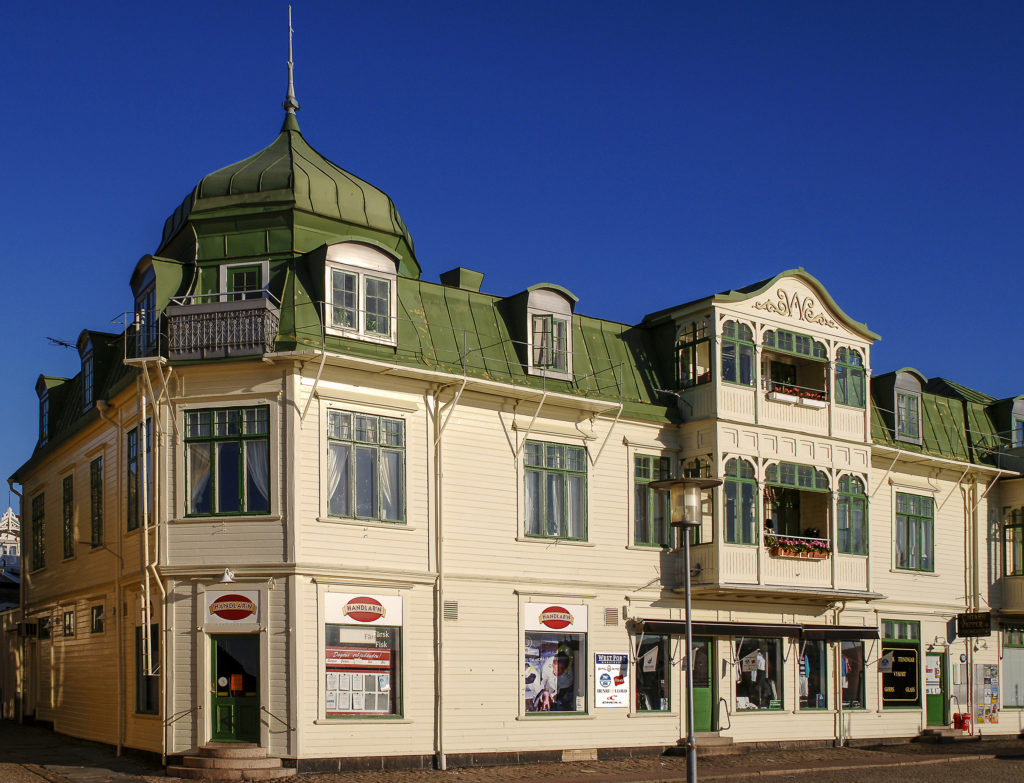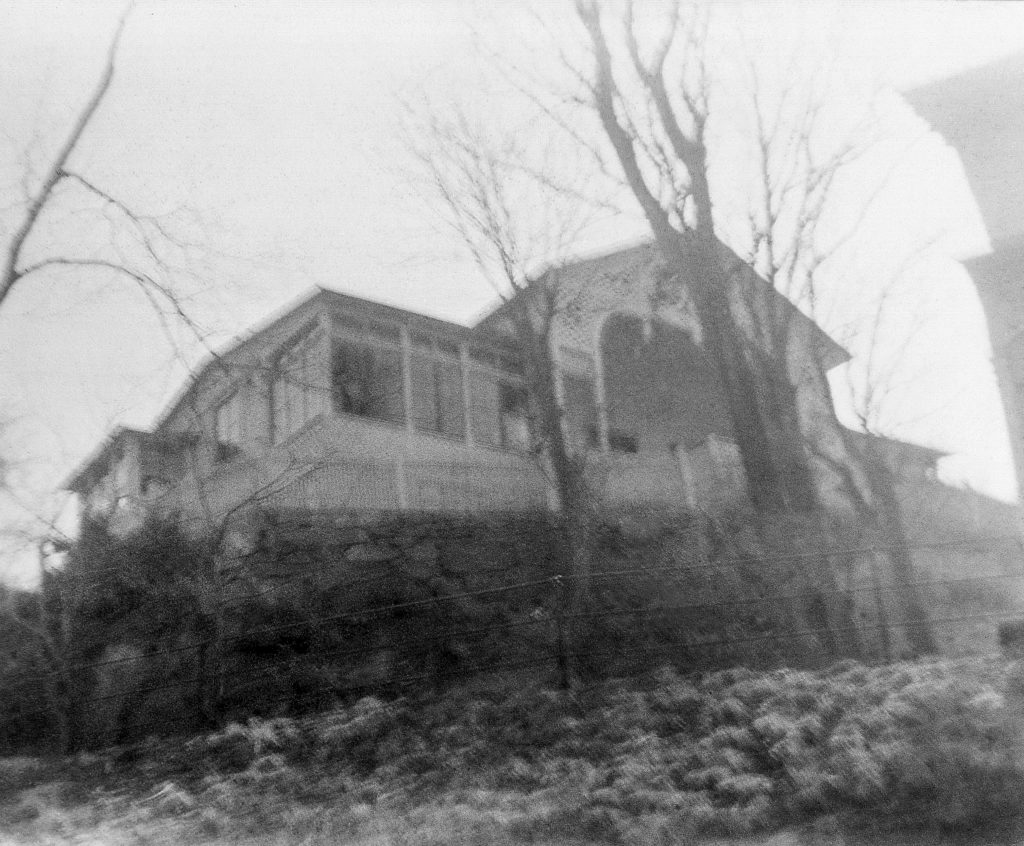Marstrand Continuum, Part I
Part One Of My Family Story. Marstrand, Sweden. The Soderbergs immigrate to Los Angeles, California from Sweden.
It is a rock. It is an island. Pre-historic man established abode here. Viking Age seafarers found the dual entrance deep harbor
much to their liking. The waters were rich with herring; and the herring made this Swedish west coast island rich. In
1658 Carlsten fortress was built atop the rock to protect the assets. Before yielding prominence to the towns of Kunglav
and Goteborg, Marstrand was the hub of trade and commerce.

Then change. The Herring population declined. Modern roads, rails and communications largely by passed Marstrand. She had to reinvent herself.
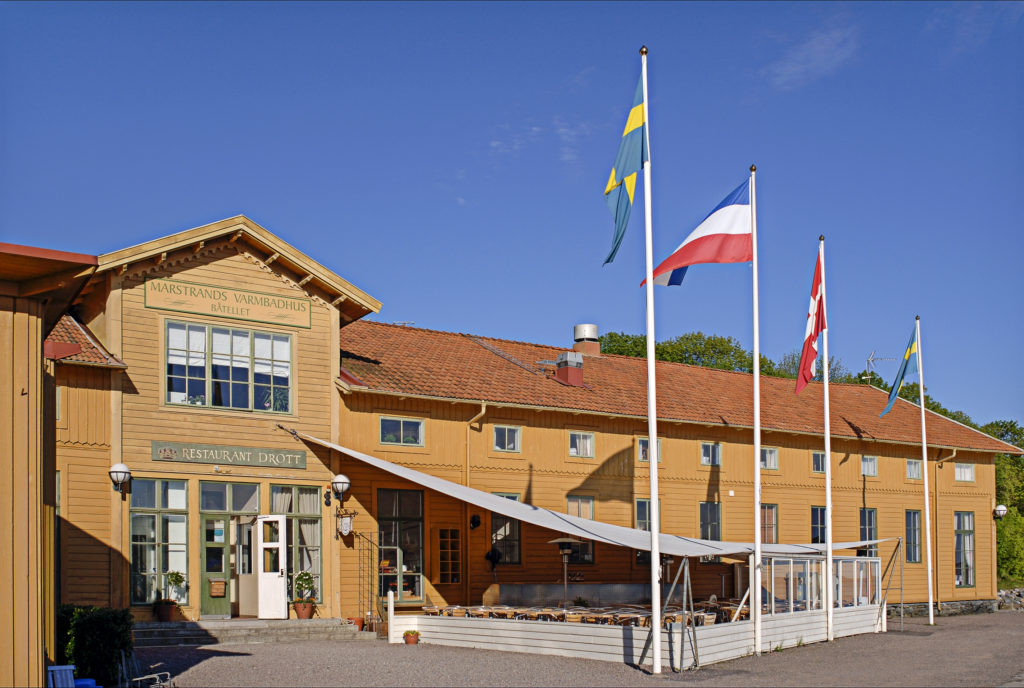
Marstrand’s Varmbadhus Båtellett. 1856 began a new direction for Marstrand. People came to relax and enjoy the theraputic warm water baths. The Island’s ion rich air and water were also highly touted for health benefits.

In 1887 Societetshuset was built. An invitation was extended to King Oscar II to visit and enjoy this beautiful social hall. To come and spend a summer in Marstrand. To bring his yacht. The King fell in love with Marstrand, as anyone might. He made it his annual summer destination.
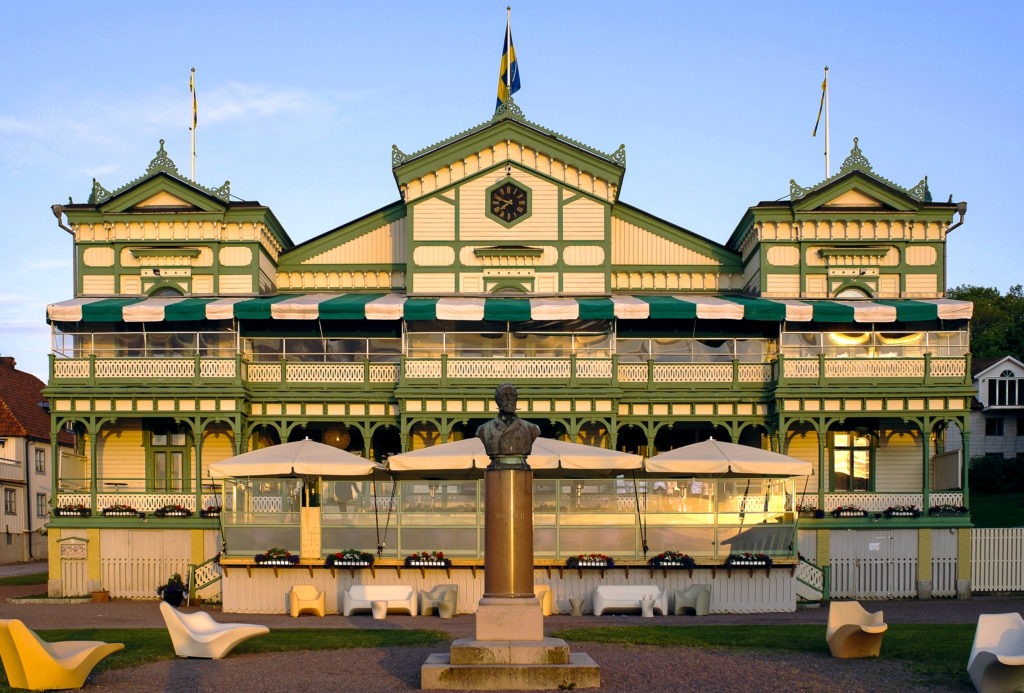
King Oscar (that’s his bust atop the post) brought with him a flush of new activity. Dances, receptions, concerts and evening entertainment became standard fare.
Cold water baths became part of the Marstrand “therapy.” Swimming, sunbathing, and hiking are also part of the resume. However its most famous attraction is sailing. During the summertime national and international sailing championships, as well as regattas, are held.
The city plot or grid dates back to medieval times. A fire or two rolled through from century to century. But the charming architecture seen today is largely from the late 19th and early 20th century. Quaint houses and beautiful structures line the narrow cobblestone streets. No cars or traffic here. It is pedestrian heaven. Grand Hotel is on the left. City Hall is straight ahead at the top of the street.
The Island is one mile in diameter. You arrive via ferry; the ride lasts only a couple of minutes. An array of fine shops and eateries are immediately accessible.
The western two thirds of the island is undeveloped. Tucked between the large smooth rocks and in all the cracks are beautiful rare maritime plants. The ocean and archipelago views are magnificent.
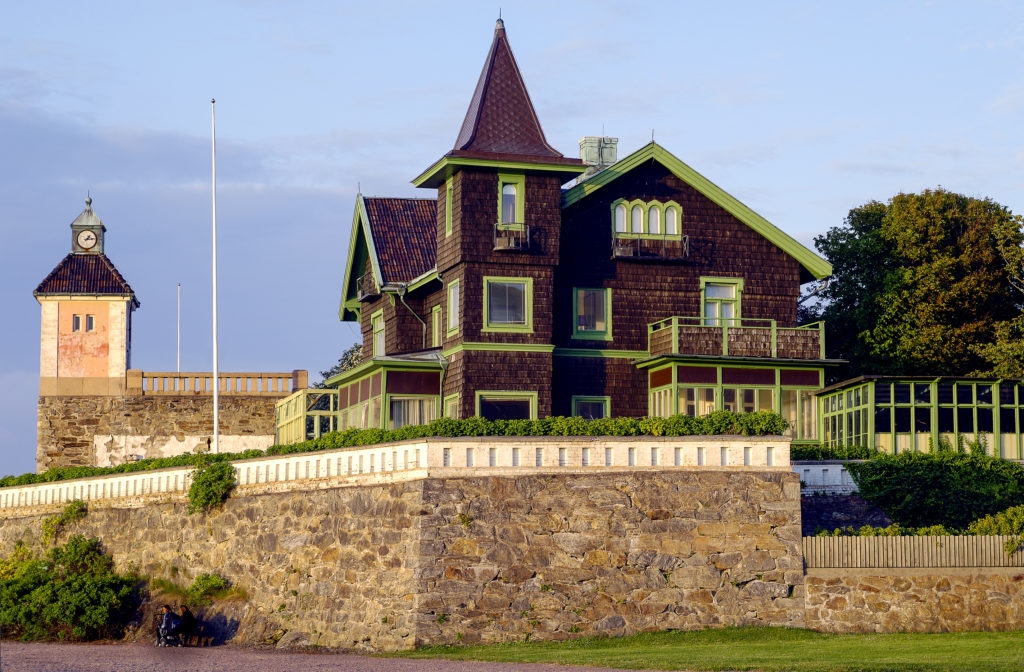
Each entrance to the harbor saw a fortified outpost (the structure on the left and the wall). The vault of that structure was used in 1780 as a synagogue. The first in Scandinavia.
It was in 1783 that the first-ever revolving lighthouse light was erected at Marstrand.
There is another first to mention. Marstrand Electric was Sweden’s first municipal electric company.

My great grandfather, (My father’s side of the family), August Palm–seated right–had lived in Malmo as an electrical engineer at a prominent hotel.
Apparently a fully wired Marstrand presented opportunity for August and his wife Alma (seated middle). He went to work for the electric company and bought a large two story house in Marstrand.
That’s my great great grandmother, seated left. But I’m not sure if she belongs to August or Alma. (I think she’s Alma’s Mom) The girl is Margit, daughter of August and Alma. And my grandmother’s sister.
The house not only served as their residence, but as a functioning element of Marstrand’s tourist economy. What we call today a “bed and breakfast.”

The former Palm residence today. Undergoing remodel work. As I captured this image a gentleman named Oskar asked about my interest in the house. I mentioned the name Palm, and that my grandmother Gunhild lived here as a teenager. Oskar moved to Marstrand in 1972. He said, “I once knew an owner of that house. I have been to many a party there. Some I remember. Some I never remembered, beginning next day.”
I mentioned Gunhild in her teens was known to have played tennis with The King, Gustav V, up at Carlsten’s Fortress.
“The king was a bit famous for that,” he said. “Young was his preference. Maybe check; you might have Royal Blood!”

As Gunhild may have appeared after tennis with The King. As a child her nickname was Gulli, meaning gold, for her hair. This photo was taken Midsommer, 1918
Gustav Söderberg, 1918. He’s standing a top a WWI Submarine. He served in the Swedish Navy.
Both Gustav Söderberg and Gunhild Palm were born in Malmo, Sweden. It is not known when or where they met.
However, writing on the back of the above photo indicates it was taken in Marstrand. In any event, they married and in 1920 were parents of Bill Söderberg. The name Bill was chosen after she read a novel with a character named Bill. William was not the name chosen.

Bill in Marstrand. Gunhild, Alma and Bill’s great grandma.
Economic Times, worldwide–the 1920’s were difficult. Agriculture, coal mining, textiles, shoes, shipbuilding and railroads were all in decline. One factor in Sweden, among others then, it had an agrarian economy in the midst of a strong population growth. With so much of the country made of solid rock, agriculture was hard to expand. Young healthy Swede’s immigrated. In the later 19th and early 20th century 1.9 million Swedes immigrated to the U.S.
Swedes kept together upon moving to the U.S. Western Illinois, Iowa, central Texas, southern Minnesota, and western Wisconsin all sprouted sizable enclaves of Swedes. Some filtered to southern California.
We can only speculate why Gustav and Gunhild Söderberg chose Los Angeles. As a carpenter and house builder, perhaps he had read about the housing boom in Los Angeles. Perhaps her experience in Sweden with some musicals and stage productions, Gunhild may have felt the draw of Hollywood.
The choice may have simply been connected with where Gustav’s port of entry to the U.S. was. He came through San Pedro in Los Angeles on September 2, 1921. We knew Gustav came in advance of Gunhild and Bill. And it was assumed he came through Ellis Island, as the two had on done later on March 6, 1923. But where was the record? Swedish family member Nicklas Rydberg provided the missing document above.
Bill wrote: “We were pushed onto the streets of New York City, unable to speak the language. And no idea of where to catch the Greyhound Bus to Hollywood, California.
“My Dad had made the trip a year earlier to build a house for us to live in. When we arrived the framing of the house was up and I think it was ready for the roof. But we had to live in a tent, cook over a camp fire, and make do with an out-house.”

Youthful happy faces showing optimism for a life in their new country.
“My mother soon came down with typhoid fever and was in the hospital for what seemed like life time to me. Meanwhile I was sent to live with some long time friends, the Andersens–also from Sweden, while my Dad finished the house; and while my Mother recovered from the fever.
I don’t recall Bill ever mentioning a period of prosperity and well being during this early period of his life. However the history learned by Nicklas Rydberg in Sweden describes Gustav being proud of his professional accomplishments and financial achievements in the United States. Gustav himself bragged about how well off he was and how much money he made. He owned a big and expensive car; a Bugatti!
Gustav Söderberg and Bill. Well appointed beach attire, from head to toe.
If there was no idea that Gustav drove a Bugatti, then this photo might nott completely make sense. Gustav wearing a driving coat? Or simply the sweater seen in the previous photo. Either way nice clothes. Not cheap.
Gustav and Bill during happier times.Gustav and Bill during happier times.
“Swedish was spoken at home. Even by second grade, my English was still not very good–the kids all made fun of the way I talked.”
Bill was held back one grade until his language skills improved.
Further work needs to be done find the address of the house on Veteran and Olympic. This is possibly one of the homes Gustav built. A house number is slightly legible.
The family home Gustav built was on Veteran and Olympic Boulevards in West Los Angeles. Olympic Boulevard was originally 10th Street; the name changed in 1928 as Los Angeles was bidding for the Olympics which came in 1932.
Bill remembered playing in the middle of Pico Boulevard catching horny toe lizards. He said Olympic Boulevard was mostly waist-high weeds growing through cracks in the pavement.
Weeds growing on what is today a busy street may have said much about the worsening economy the young Soderbergs faced. 1926/1927 saw a sharp decline in construction. By the end of 1928 all construction came to a grinding halt. That amounted to $2 billion dollars no longer moving through the economy. Gustav wasn’t paid for his work. His own bills went unpaid. Gustav must have felt desperation. He proposed moving.
Gunhild was not receptive to that proposal. She had enough of moving and was not about to start over again.
It was too hard getting into this country, and we’re not leaving.
Bill wrote that the last time Bill heard from his father was via a birthday card sent from Brazil, 1927. He believed and said his father finally settled in Australia. Greta had also been told that Gustav went to Australia where he became a Communist and an alcoholic.
Two people with accurate information read this blog and have help correct the history presented. One is Berit Hären in Stockholm. She informed me that Gustav returned to Sweden. Gustav Helge and Gunhild were divorced through California divorce court on Nov. 10, 1932. (Bill was 12 years old). In 1935 Gustav Helge remarried to Magnhild Viktoria at Johannes parish, Stockholm in a civil service. Not known to Bill, he would have a half sister in Sweden and as well as Greta in the U.S.
Other information and photos come from Gustav’s Swedish grandson Nicklas Rydberg (my newly found cousin) Nicklas described Gustav as a man with strident political beliefs, and he confirmed Gustav was indeed a devout Communist. My mother confirmed, she wrote, “my memory of stories of Gustav arguing his political views and making enemies on the way. My mother tells it was hard to grow up in small country society with a dad like that.”
But more about Gustav later. Back to the story in Los Angeles.
Gunhild and Bill were alone and had to abandon, and actually walk away from, their home in West Los Angeles. Bill often spoke of the long hike they made with their suitcases along weedy Olympic Boulevard to downtown Los Angeles as a homeless family.
A kindly group of women observed their plight. They opened their doors to shelter and care for them until Gunhild was able to fend for her herself. These kind people were a Madame and her Girls.
The next installments of Marstrand Continuum: Depression Era life in Downtown Los Angeles. Gunhild Remarries.
Bill gets a sister, Greta. Bad news from Sweden. Gunhild and Greta must visit Marstrand. A life in Sweden. Getting trapped in Sweden by the developing world war. Escape. Fast forward to 2006–Greta returns to Marstrand for the first time since her escape in 1940. Stay tuned!


